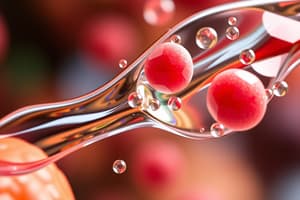Podcast
Questions and Answers
What is the primary driving force behind the process of diffusion?
What is the primary driving force behind the process of diffusion?
- Surface area of the membrane
- Temperature fluctuations
- Concentration gradient (correct)
- Energy from ATP
Which of the following accurately describes osmosis?
Which of the following accurately describes osmosis?
- Osmosis is dependent on ATP.
- Water moves from low solute to high solute concentration without a membrane.
- Water always moves into a hypertonic solution.
- Water moves through a selectively permeable membrane from low to high solute concentration. (correct)
In active transport, which of the following is required?
In active transport, which of the following is required?
- Selective permeability of the membrane
- Temperature change
- Energy in the form of ATP (correct)
- Gradient of solutes
What distinguishes primary active transport from secondary active transport?
What distinguishes primary active transport from secondary active transport?
Which type of endocytosis involves the engulfing of large particles?
Which type of endocytosis involves the engulfing of large particles?
During exocytosis, what occurs within the cell?
During exocytosis, what occurs within the cell?
What role do transport proteins play in facilitated diffusion?
What role do transport proteins play in facilitated diffusion?
Which of the following factors does NOT influence the rate of diffusion?
Which of the following factors does NOT influence the rate of diffusion?
Which of the following describes a hypotonic solution in relation to a cell?
Which of the following describes a hypotonic solution in relation to a cell?
What process involves the specific uptake of molecules via receptor binding?
What process involves the specific uptake of molecules via receptor binding?
What is the primary characteristic of diffusion?
What is the primary characteristic of diffusion?
Which of the following best describes the role of osmotic pressure in cells?
Which of the following best describes the role of osmotic pressure in cells?
In the process of active transport, how do molecules move?
In the process of active transport, how do molecules move?
Channel proteins differ from carrier proteins in that they:
Channel proteins differ from carrier proteins in that they:
Which statement correctly describes phagocytosis?
Which statement correctly describes phagocytosis?
What role do vesicles play in exocytosis?
What role do vesicles play in exocytosis?
Which of the following is a characteristic of isotonic solutions?
Which of the following is a characteristic of isotonic solutions?
What distinguishes primary active transport from secondary active transport?
What distinguishes primary active transport from secondary active transport?
Which factor does NOT affect the rate of diffusion?
Which factor does NOT affect the rate of diffusion?
What is a defining feature of carrier proteins?
What is a defining feature of carrier proteins?
Flashcards are hidden until you start studying
Study Notes
Cell Transport
Diffusion
- Process of movement of molecules from an area of higher concentration to an area of lower concentration.
- Does not require energy (passive transport).
- Occurs until equilibrium is reached.
- Factors influencing diffusion:
- Concentration gradient
- Temperature
- Surface area
- Size of molecules
Osmosis
- Special type of diffusion specifically for water molecules.
- Water moves through a selectively permeable membrane from an area of lower solute concentration to an area of higher solute concentration.
- Can be isotonic (equal concentration), hypertonic (higher solute concentration outside), or hypotonic (lower solute concentration outside).
- Essential for maintaining cell turgor pressure in plants.
Active Transport
- Movement of molecules against their concentration gradient (from low to high concentration).
- Requires energy (ATP).
- Types of active transport:
- Primary active transport: Direct use of ATP (e.g., sodium-potassium pump).
- Secondary active transport: Uses the energy from the electrochemical gradient created by primary transport (e.g., glucose transport).
Endocytosis and Exocytosis
-
Endocytosis: Process by which cells engulf external substances, packaging them into vesicles.
- Types:
- Phagocytosis: "Cell eating" – engulfing large particles.
- Pinocytosis: "Cell drinking" – engulfing liquids.
- Receptor-mediated endocytosis: Specific uptake of molecules based on receptor binding.
- Types:
-
Exocytosis: Process of vesicles fusing with the cell membrane to release their contents outside the cell.
- Used for secretion of hormones, neurotransmitters, and waste removal.
Transport Proteins
- Integral membrane proteins that facilitate the movement of substances across the cell membrane.
- Types:
- Channel proteins: Form pores that allow specific ions or water to pass through.
- Carrier proteins: Bind to specific molecules and change shape to shuttle them across the membrane.
- Important in facilitated diffusion and active transport processes.
Cell Transport
Diffusion
- Movement of molecules from high to low concentration areas without energy input.
- Occurs until a state of equilibrium is achieved.
- Influencing factors include:
- Concentration gradient: The difference in concentration across distances.
- Temperature: Higher temperatures increase molecular movement.
- Surface area: Greater surface enhances diffusion rates.
- Size of molecules: Smaller molecules diffuse more easily.
Osmosis
- Specialized diffusion for water molecules across a selectively permeable membrane.
- Water moves from lower solute concentration to higher solute concentration.
- Can occur in three conditions:
- Isotonic: Solute concentrations are equal inside and outside the cell.
- Hypertonic: Higher solute concentration outside the cell, causing it to shrivel.
- Hypotonic: Lower solute concentration outside the cell, leading to swelling and potential bursting.
- Vital for maintaining turgor pressure in plant cells, providing structural support.
Active Transport
- Involves movement of molecules against their concentration gradient (low to high).
- Requires energy in the form of ATP for operation.
- Two main types:
- Primary active transport: Direct ATP usage to move ions (e.g., sodium-potassium pump).
- Secondary active transport: Utilizes energy from the electrochemical gradient formed by primary transport for other substances (e.g., glucose transport).
Endocytosis and Exocytosis
- Endocytosis: Cellular process of engulfing external substances and encapsulating them in vesicles.
- Types include:
- Phagocytosis: "Cell eating" for large particles.
- Pinocytosis: "Cell drinking" for liquid uptake.
- Receptor-mediated endocytosis: Specific absorption based on receptor interactions.
- Types include:
- Exocytosis: Vesicles fuse with cell membrane to release substances outside the cell.
- Crucial for the secretion of hormones, neurotransmitters, and waste elimination.
Transport Proteins
- Integral membrane proteins that assist in moving substances across the cell membrane.
- Two primary types:
- Channel proteins: Create pores allowing selective passage of ions or water.
- Carrier proteins: Bind to specific molecules, changing shape to transport them across the membrane.
- Essential for processes in facilitated diffusion and active transport.
Cell Transport Study Notes
Diffusion
- Movement of molecules from high concentration to low concentration.
- Passive process that requires no energy expenditure.
- Occurs until equilibrium is achieved in the system.
- Influenced by concentration gradient, temperature, surface area, and distance.
Osmosis
- A specific diffusion focused on water molecules through a selectively permeable membrane.
- Water naturally relocates from areas of low solute concentration to high solute concentration.
- Tonicity classifications:
- Isotonic: solutions with equal solute concentrations.
- Hypertonic: solutions with higher solute concentrations.
- Hypotonic: solutions with lower solute concentrations.
- Osmosis is crucial for maintaining turgor pressure in plant cells.
Active Transport
- Involves movement of molecules against their concentration gradient, from low to high concentration.
- Requires energy, specifically in the form of ATP.
- Includes:
- Primary active transport, which directly utilizes ATP.
- Secondary active transport, which derives energy from primary transport processes.
- Notable examples include the sodium-potassium pump and proton pumps, critical for cellular function.
Transport Proteins
- Specialized proteins that aid in the movement of substances across cell membranes.
- Types of transport proteins include:
- Channel proteins, which create pores for specific molecules to pass through.
- Carrier proteins, which bind to molecules and alter shape to facilitate transport.
- Function in both passive (facilitated diffusion) and active transport mechanisms.
Endocytosis
- Refers to the process where cells engulf materials from their surroundings.
- Types of endocytosis include:
- Phagocytosis: the engulfing of large particles, often called "cell eating."
- Pinocytosis: the absorption of liquids, commonly referred to as "cell drinking."
- Receptor-mediated endocytosis: involves selective uptake through specific receptors.
- This process is energy-dependent, utilizing cellular resources for transport.
Exocytosis
- Mechanism by which cells expel materials into the extracellular environment.
- Involves vesicles that fuse with the plasma membrane, releasing their contents outside the cell.
- Plays a critical role in processes such as neurotransmitter release, hormone secretion, and the elimination of waste products.
- Like endocytosis, exocytosis is also an energy-dependent process.
Studying That Suits You
Use AI to generate personalized quizzes and flashcards to suit your learning preferences.




